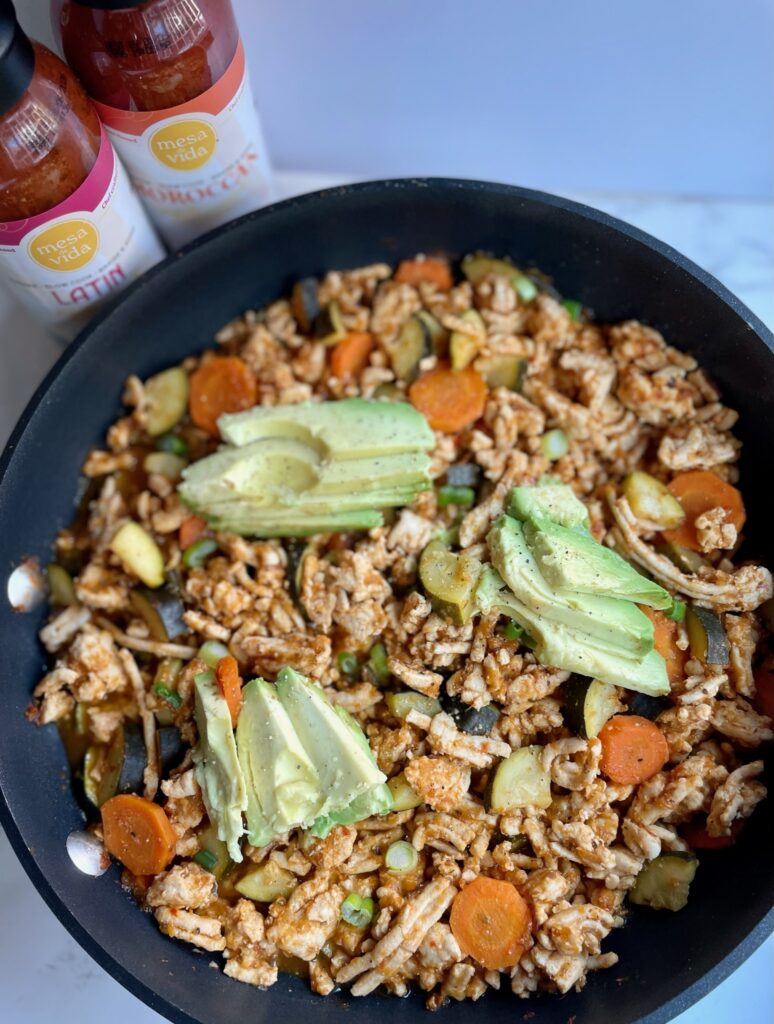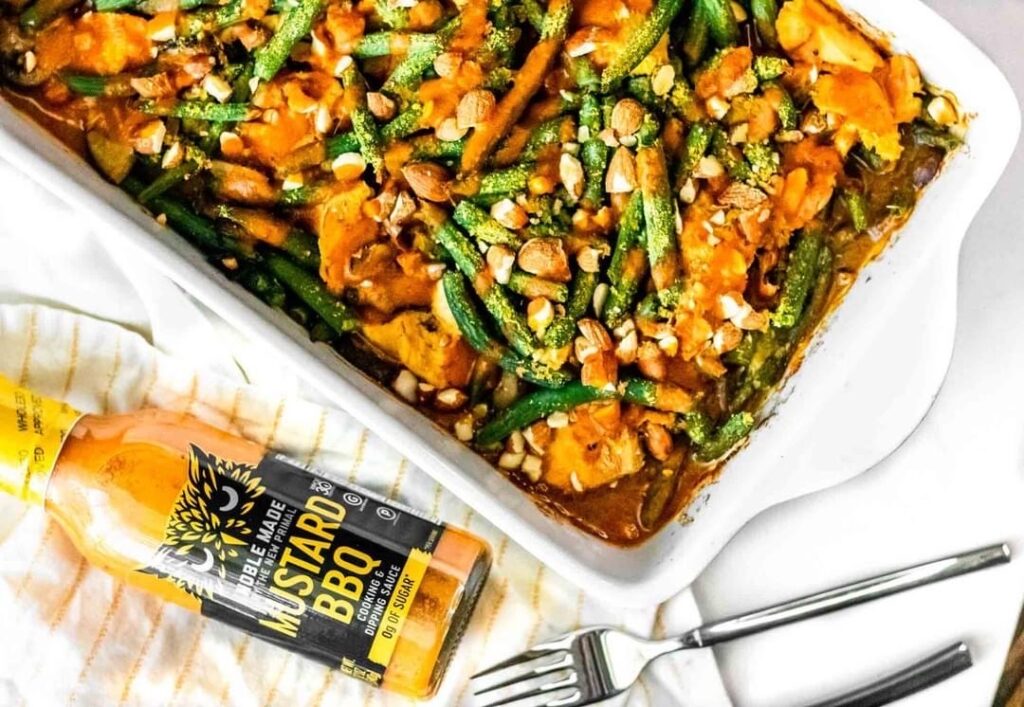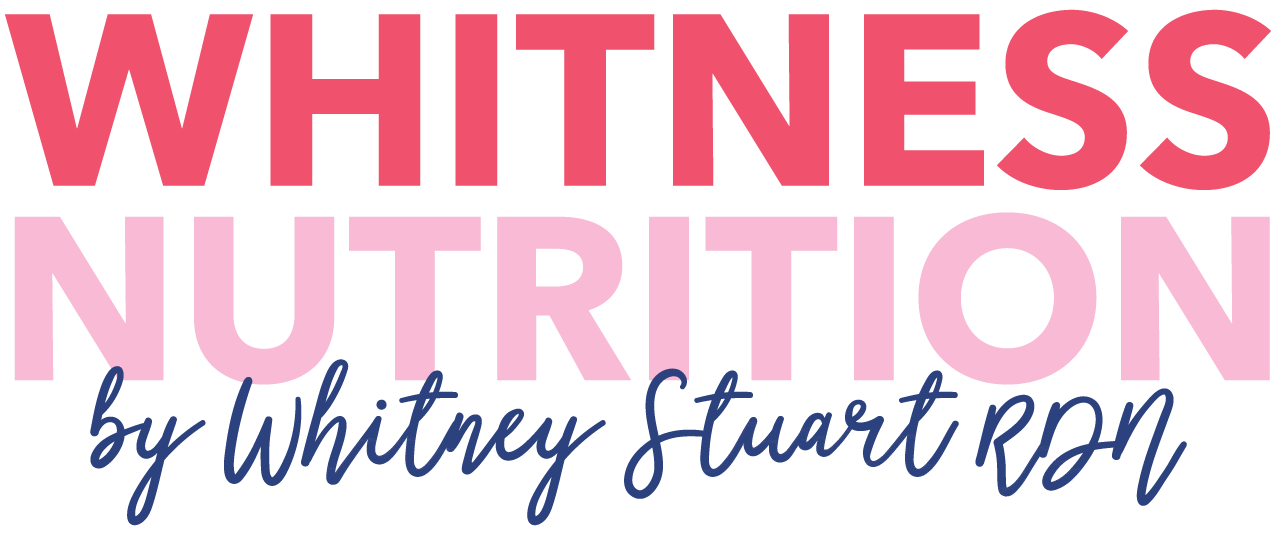Healthy Sauce Choices: what’s sneaking in your sauce
Stop what you’re doing and take a minute to consider – what are the ingredients in that BBQ sauce sitting in your fridge? What about the taco sauce stored in your pantry? If haven’t been wondering, now you should be! Today, I’m sharing my favorite sauces that are better for blood sugar with less added sugar and are naturally free of gluten and dairy.
As a Registered Dietitian and sauce enthusiast, I’m here to tell you the saucy truth.
Healthy Sauce Choices: What’s Sneaking in Your Sauce
What are the healthiest sauces?
Unfortunately, many common commercial condiments and sauces are filled with ingredients working against your health. Particularly, soybean oil, added sugar, artificial coloring and dyes. These ingredients are known to contribute to inflammation and chronic disease. This is why Whitness Nutrition emphasizes the importance of educating on label reading and knowing how to look out for sneaky ingredients. As you know, sugar isn’t always just sugar, nor is the term “oil blend” always a good thing. One of the biggest culprits when it comes to having hidden ingredients and tricky marketing tactics are, you guessed it, jar and bottled sauces.
And honestly? I’m tired of all the seemingly healthy sauces on the market tricking my patients (and even me!) with hidden ingredients and unnecessary fillers. I mean really, does Italian dressing need to add cane sugar and highly processed safflower oil? No, it really does not.
What are the best low sugar sauces on the market?
Keep scrolling to find out the best blood sugar friendly swaps for four popular sauces. I determined this list while considering each sauces:
- sugar content
- ingredient base
- type of fat source
- ingredients list!
It may just surprise you which sauce makes or breaks the #WWWO approved sauce list!
But first, let’s talk about the importance of label reading.
When you’re looking at the ingredient’s list, consider how many ingredients are present and secondly, if they truly seem necessary. With this in mind, marinara seems pretty basic right? Tomatoes, basil, herbs, olive oil and simple seasonings. Marinara should be a simple recipe, but many companies opt to save money and fill their jars with high fructose corn syrup and vegetable oil. As you can imagine, these sauces are substantially cheaper for the producer, but they offer no nutritional value to the consumers – that’s you and me!
First, read the ingredient list, and note that it will be in order of strongest presence to least present. The first ingredient is the bulk of the recipe; the farther you get down the list, the less prevalent that ingredient is. This is important to be aware of because the first three ingredients, at minimum, should contain zero sources of added sugar, artificial sweeteners and inflammatory oils.
Second, review the nutritional breakdown of the macronutrients. Where does your favorite sauce fall into the our VPFC method? Many sauces will fall within the fats category, but some that are primarily veggie will fall into the carbohydrate category. For example, if you add pesto to your pasta, that pesto is going to contribute to your total fat due to the oil, cheese and nuts. But, if you’re doing a simple tomato sauce, this contributes to your carbohydrates per serving. Hence, why knowing how to read the label is always so important!
Lastly, check the added sugar! We want to aim for limited added sugars. This is because the added sugar could be a potential inflammatory food. Instead, we want naturally occurring sugars that may be present from the fruits and vegetables in a recipe.
What sauce has the lowest sugar?
The healthiest and blood sugar friendly sauce swaps!
1. Swap Shelf Stable Pesto for Trader Joe’s Cashew Kale Pesto
Conventional shelf-stable pesto is full of added sugar, vegetable oil and highly-processed cheese. For example, Rao’s shelf-stable pesto contains 2g of added sugar per serving from both sugar and dried glucose syrup. Furthermore, that same serving contains 43% of your daily sodium needs! But, not all store bought sauces are unhealthy though! Trader Joe’s fresh Cashew Kale Pesto is made with real-food ingredients full of antioxidants and heart healthy fats. One serving has 18g of healthy fats from cashew butter and extra virgin olive oil. It contains no added sugars, and has half the sodium of Rao’s. Clearly, I’m going with the more fresh and more flavorful option!
What is the best marinara sauce for diabetes?
2. Swap the marinara with added sugar for Rao’s No-Sugar added Marinara
The award-winner of sneaky sauces goes to jarred marinara! As I mentioned previously, many conventional marinaras use added sugar to emphasize the already sweet and tart tomatoes. For example, Bertolli Marinara sauce contains 2g of added sugar. Many marinara sauces use inflammatory vegetable oil, like Prego, which uses canola oil. For this reason, a no-sugar added marinara like Rao’s is a much more blood-sugar friendly and nutrient-dense option. Rao’s uses seven simple ingredients, one of which is olive oil, contributing 7g of healthy fats per ½ cup serving. Pair your no-sugar added marinara with non-starchy veggies and lean protein for a blood-sugar bliss meal. This zoodles and meatballs is a Sunday dinner staple in our house!
3. Swap traditional BBQ Sauce for The New Primal BBQ Sauce

Unfortunately, BBQ sauces are infamous for being a high-glycemic sauce, but don’t worry, there are better alternatives! Take the notorious Sweet Baby Ray’s BBQ sauce. This is arguably one of the most popular BBQ sauces on the market. It’s made with FIVE different forms of added sugar. That list of added sugars includes high fructose corn syrup, cane sugar and molasses. A 2 tbsp serving of SBR has 16g added sugar, as well as 13% of your daily sodium intake. Thank goodness for the healthy bbq sauces on the market! The New Primal BBQ sauce is my personal favorite and go-to BBQ sauce swap. It’s naturally sweetened with pineapple juice and only contains 4g of sugar per 2 tbsp serving; 75% less than Baby Ray’s! The New Primal also uses apple cider vinegar which can help maintain a stable blood sugar during digestion. For this reason, my personal favorite is The New Primal Mustard BBQ Sauce. It’s tangy, tart and so delicious with grilled chicken or in a veggie casserole!
4. Swap soy sauce for coconut aminos
Finally, an easy way to decrease your sodium intake is by swapping traditional soy sauce for coconut aminos. Coconut aminos are made from the sap of young coconut trees. The sap is combined with salt to ferment and provide that soy-sauce-like taste. A bottle of coconut aminos contain 70 to 75% less sodium than regular soy sauce and still provides that savory, salty flavor. They are an excellent anti-inflammatory swap for those looking to reduce non-organic non-GMO soy intake. My personal favorite is Bragg’s Coconut Aminos, which has 140mg of sodium per 1 tsp serving. Traditional soy-sauce contains around 960 mg of sodium per 1 tbsp serving. Clearly, coconut aminos are a much more blood-sugar friendly option! Even low-sodium soy sauce contains around 590 mg of sodium per tablespoon, that’s 1/4th of your daily sodium intake!
5. Swap traditional pad thai sauce for Yai’s Thai Pad Thai Sauce
Pad Thai Sauce is similar to barbecue sauce; loaded with concentrated sugar and in normal types 2 tablespoons contain 11g of added sugar. Remember, the recommendation for added sugar is 24g daily. But, this lovely flavorful alternative contains only 1 gram of added sugar and is naturally gluten free and dairy free. Traditional versions are often culprits of large blood sugar spikes as this concentrated sweetener even in small amounts has a large impact.
6. Swap your ketchup for True Made Foods No Sugar Added Ketchup
The ingredients in this ketchup are stellar and the bottle is still a fun squeeze style for your toddler’s to dose their nuggets in! The flavor is enhanced with servings of fruit and vegetable; Tomato Concentrate, Apple Puree Concentrate, Distilled Vinegar, Carrot Puree, Butternut Squash Puree, Salt, Onion Powder, Allspice. I’ve tried almost all of the ketchups on the market and this one makes the cut – where most don’t!
7. Swap your traditional Mayo for Aveyo Avocado Mayo!
This is a new offering that recently launched at Whole Foods. Not only is this mayo made of avocado, but it’s oil free. While many heart-healthy oils are now made from avocado oil, this is a potassium-rich, lower calorie, option that is just as creamy but found in the fresh foods section of the grocery store as a blend of avocado, vinegar and spices. I’ve been using this in my tuna salad recipes and love the slight tang!
Use smarter sauce swaps to upgrade your veggies and take broccoli from bleh to yeah!
- Cashew Kale Pesto with Spaghetti Squash or Zoodles
- The New Primal BBQ Sauce with Roasted Carrots and Butternut Squash
- Mesa De Vida various simmer Sauce recipes are a true favorite; I use them with with zucchini and onions or drizzled on a grain bowl
- Primal Kitchen Teriyaki Sauce with wok-style stir fried veggies
- Siete Foods Enchilada Sauce with fajita peppers and onion
- I have been obsessed with dipping my Persian cucumbers in this Vegan Creamy Dill Dressing. This is a great option to use for a salad dressing, too!
Shop all of my favorite sauces here!
Don’t let the food and beverage industry trick you with their marketing tactics and sneaky ingredients! Book a discovery call to learn more on label reading, grocery shopping tactics and how to upgrade your meals with sauce with a registered dietitian-nutritionist.









Rao is made with olive oil which is not inflammatory. Also, canola oil is not inflammatory. It is 63% monounsaturated fatty acid, predominantly oleic acid, which is an omega 9 and helps decrease inflammation. Please stop pushing false information.
Diane! Yes. Oh my goodness, thank you much for reiterating the EXACT thing I said in this article. You read that correctly. That I agree with you. As I said – Rao is made with olive oil which is not inflammatory. Well done!
And yes, isn’t omega-9 amazing./ Olive oil contains significantly more omega-9 fatty acids than canola oil.
– **Olive oil** (especially extra virgin) is about **70-80% omega-9 (oleic acid)**.
– **Canola oil** contains around **55-65% omega-9**—still a good source, but lower than olive oil.
### **Why Does This Matter?**
– **Oleic acid (omega-9) is linked to heart health, reduced inflammation, and improved insulin sensitivity.**
– Olive oil’s **higher omega-9 content + antioxidants** (like polyphenols) make it more **stable** for cooking and healthier overall.
– Canola oil, while containing some omega-9, is more processed and has **more omega-6**, which can contribute to inflammation when consumed in excess.
Bottom line: **Olive oil is the superior source of omega-9s and a better choice for health!**